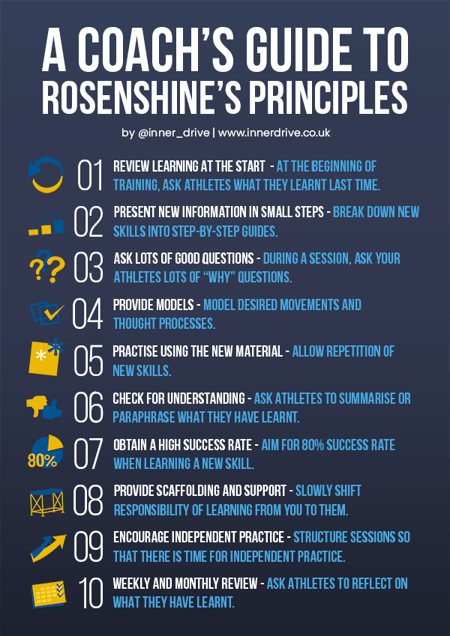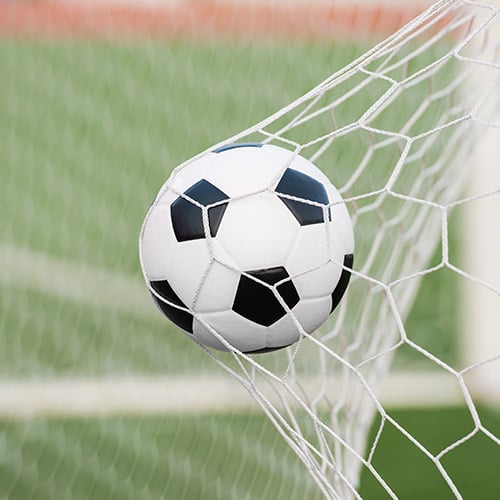Rosenshine's Principles of Instruction have the potential to revolutionise coaching. Although they're based on teaching guidelines underpinned by cognitive science, we think they can be useful for coaches as well.
If used correctly, these principles can help anyone learn anything much more effectively, especially in sport. So what are Rosenshine’s Principles of Instruction - and how can you apply them?
 First principle: Review learning at the start
First principle: Review learning at the start
The first principle suggest to review what you previously learnt at the beginning of a session. This is because our cognitive load (how much information we can hold in our working memory at any one time) is quite small. This means that if we have to remind ourselves of previous information every time we try to learn new information, it will get in the way.
How to apply this in sport
Ask your athletes to review and evaluate what they learnt in previous training or analysis sessions. This will help your athletes to develop a more in-depth understanding of what skill or movement they learnt, allowing them to make connections between skills and enhance their understanding of what they are doing and why they are doing it.
For example, asking athletes to demonstrate what they learnt last session and explain why it is important at the beginning of training might be a nice way of embedding this.
Second principle: Present new information in small steps
Rosenshine's second principle is all about tackling the main limitation of our working memory: it’s small.
Presenting someone with too much information at once leads to their brain suffering from something called overload. Cognitive Load Theory explains how our working memory has a limited capacity. When the brain becomes overloaded with information, the learning process slows down or even stops because all the information being presented at once cannot be processed. Therefore, Rosenshine suggests information should be presented in small steps.
How to apply this in sport
This is particularly important when teaching your athletes new skills or patterns of play. You should try and simplify the movement, and not overload the athlete with information to begin with. You could try breaking the skill down into steps and giving only one or two tips or corrections at a time in order to avoid overloading with things they need to change, leading to no improvement.
In addition, when presenting information to athletes, make sure you don’t present too much. If you do, athletes won’t know what to focus on. This is the basis of the Redundancy Effect.
Third principle: Ask lots of good questions
In education, asking questions is one of the most powerful ways for a teacher to enhance learning and encourage them to explore the topic in more depth. In schools, it determines how well the students are remembering material and if they need to go over the topic again. It improves students' metacognition (the ability to recognise and choose their thought processes), allows them to be more inquisitive and enhances learning by requiring them to practise retrieval.
Pre-questions (questions about what they’re about to learn, to get them to start thinking) before teaching can help students remember better; elaborative interrogation (essentially, “why” questions) can be used after to force students to think more deeply about what they just learnt.
How to apply this in sport
At the start of a session, use pre-questions: ask your athletes questions about the skill you are about to teach them. During the session, you should ask lots of “why” questions, such as why they need to open up their body, or jump out of the floor higher. These “why” questions are called elaborative interrogation. Here are 6 questions that Rosenshine suggests that you ask your athletes:
- "What is the main idea of ...?"
- "What are the strengths and weaknesses of ...?"
- "How does this tie in with what we have learnt before?"
- "Which one is the best ... and why?"
- "Do you agree or disagree with this statement: ...?"
- "What do you still not understand about ...?"
Fourth principle: Providing a model
Providing a model or worked example of how to do something helps make connections and links within your learning, leading to better memory recall. It also allows you to understand the information quicker and aids learning as it allows you to focus on the specific task at hand, reducing the overall demand on your cognitive load.
How to apply this in sport
Modelling an action or a thought process to your athletes will be really helpful. This helps to encourage observation/vicarious learning. This may also aid your athletes’ ability to visualise performing a skill, which in turn enhances their confidence. Here, you should also use those “why” questions to ensure that information is being transferred to their long-term memory.
Fifth principle: Practise using the new material
Rosenshine's fifth principle is about guiding student practice. This is important: the more you practise rehearsal, the easier it becomes to retrieve this information when they need it. This means that students need enough time to practise retrieval, ask questions and get the help they need to make connections between their new learning and old learning.
How to apply this in sport
- Aim to structure your session so that athletes use repetition. Set them tasks of successfully completing the skill ‘X’ number of times.
- Set time at the end of the session, or in between practising different skills, to allow athletes to ask questions, to check they are doing it correctly, and to practise it with another person or in a game situation. This will help them to execute the skill when it matters the most.
- In addition, during this stage, athletes will make mistakes and sometimes struggle. Thus, it’s important to motivate athletes by helping them to reframe their “I can’t do this” to “I can’t do this yet”.
Sixth principle: Check for understanding
Rosenshine suggests taking intermittent periods throughout the lesson to stop and gauge whether students are understanding the material. It helps to nip any misconceptions or misunderstandings in the bud.
How to apply this in sport
Asking athletes to summarise or paraphrase what they are learning forces them to determine what information is relevant and useful.
- You should also check their responses when you ask them questions to gauge how confident your athletes feel about a new skill or task. For example, when asking athletes what the answer is, you should also ask them how confident they are that they can repeat the skill.
- You could also ask the group to demonstrate to each other in pairs whilst keeping an eye out for anyone who is struggling.
Seventh principle: Obtain a high success rate
Rosenshine's seventh principle suggests that the optimal success rate teachers should strive for is 80% as this shows that students are understanding and learning new material while still being challenged. This gives students confidence in their ability and motivation to work hard without becoming complacent.
How to apply this in sport
You too should develop an environment where you can develop high success rates to inspire both confidence and motivation. Setting challenging, but realistic goals is important here.
In addition, having both high levels of challenge and support is important. If the challenge is too high, then this could mean burnout; too low and it could be too comfortable.
However, the perfect combination is where development takes place. Want to know how else you can develop resilience in elite environments? We have written on this subject here.
Eighth principle: Provide scaffolding and support
Rosenshine's eighth principle is about scaffolding, which refers to gradually reducing assistance as students become more comfortable and fluent with the concept or skill. This shifts responsibility over the learning process from the teacher to the student, helping students reach a higher level of skill acquisition and grasp complex concepts faster.
Want to see a quick example of scaffolding? Check out this video:
How to apply this in sport
Scaffolding can be provided in a range of ways. For example, you could break big skills or tasks into smaller parts. Good feedback is important here.
Modelling how to complete a skill or pattern of play will also really help. Another nice way to use scaffolding is to use a skill checklist of things they need to do to be able to complete the skill. Then, slowly take the checklist away until they need very little support.
Ninth principle: Encourage independent practice
Rosenshine's ninth principle is all about encouraging independent practice. Developing independent learners is important as it helps students to stay motivated and improve their academic performance. It allows students to take responsibility for their own learning and develop a sense of purpose.
How to apply this in sport
- Structuring sessions so that there is time for independent practice at the end is helpful. Here, you can monitor the practice that your athletes are doing.
- Setting tasks to complete between sessions to repeat a skill will help them to cement it.
- Helping your athletes highlight what they need to improve and allowing them to work out how to practice it shifts the onus onto them.
- If you coach young athletes, engaging with their parents to ensure practice is taking place can help too.
- Using skill trackers or performance profiles can help athletes identify what they need to work on.
Tenth principle: Weekly and monthly review
Rosenshine’s 10th and last principle is an extension of the first one, and emphasises the importance of encouraging students to engage in weekly and monthly reviews of their newly-acquired knowledge. This allows them to make connections between new information and old knowledge, enhancing their understanding of a topic.
How to apply this in sport
- This could be done in the form of asking them to reflect on the training they did that week, and then again at the end of the month.
- Set an activity to test the skills they’ve learnt - for example, doing an in-house match at the end of the week.
- Asking athletes what they have learnt that week/month then asking them to demonstrate it is a nice way to review their progress.
Final thoughts
It is important to note that, although all of Rosenshine's Principles are important and effective, they may not always translate to every setting and every sport. They don’t all need to be used at once, and you should remember that they are designed to be adapted and evaluated.
We recommend trying out some of Rosenshine's Principles in your coaching to help with athlete motivation, independence and the learning of new skills. Use this guide to help you understand more about the principles - but be creative with your use of them.





